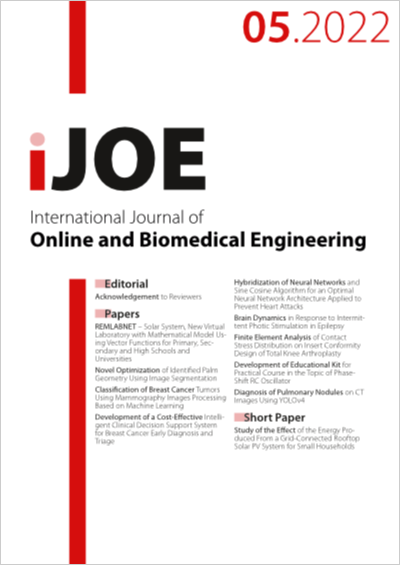Development of Educational Kit for Practical Course in the Topic of Phase-Shift RC Oscillator
DOI:
https://doi.org/10.3991/ijoe.v18i05.29131Keywords:
Trainer kit, Phase-shift RC Oscillator, Op-Amp, Practical courseAbstract
This research develops a phase-shift RC Oscillator trainer kit that can be used to give undergraduate students an understanding of one of the materials related to analog circuit practicum. The Oscillator is one of the essential subtopics to be examined thoroughly by electrical engineering students. Furthermore, the Resistor and Capacitor modules were provided separately to be connected to the trainer through jumper cables. The phase-shift RC circuit in the trainer kit used a single Op-Amp 741 while the Network model utilized an Inverting Amplifier to determine the gain which must be ≥ 29 times, therefore, Rfeedback ≥ 29 Rgain (Rfeedback = 30 kΩ and Rgain = 1 kΩ). Two tasks in this learning media were completed by students, namely measuring the output frequency and observing the phase shift. The output signal on this trainer kit was observed using only an Oscilloscope and a frequency counter. The phase inverter of the phase-shift RC Oscillator adjusts the output signal by 180o and sends feedback to the input, therefore, there is positive feedback. Meanwhile, the trainer kit had an output frequency specification of ~649 Hz (C = 100 nF, R = 1 kΩ) and it shifts the phase by 60o on each RC network. Using 2 and 3 R-C networks, the phase shifts were 120o and 180o, respectively. The trainer kit was packaged in a box made of acrylic with dimensions l x w x h = 20 cm x 28 cm x 5 mm. Through a questionnaire consisting of 13 criteria, this trainer kit was declared valid, namely r count > 0.2960 (5%) and reliable (Cronbach's alpha > 0.60, which was 0.732) to be used as a learning media based on user responses, namely students (N = 35). In the context of technical education, this trainer kit also supports the efficient implementation of practicum without compromising the learning objectives due to the ease of operation (plug & play through jumper cables) compared to fully assembling the circuit using a project board.
Downloads
Published
How to Cite
Issue
Section
License
Copyright (c) 2022 Syifaul Fuada

This work is licensed under a Creative Commons Attribution 4.0 International License.


